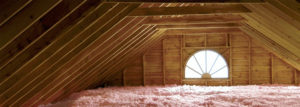 The heating and cooling costs of an average home account for 70 percent of its annual energy bills, according to the U.S. Department of Energy. Furthermore, in homes without insulation in the ceiling or roof, as much as 45 percent of the energy is lost through the roof. You cans save money with insulation and reduce energy bills by as much as 40 percent while simultaneously improving the comfort level of the home’s interior.
The heating and cooling costs of an average home account for 70 percent of its annual energy bills, according to the U.S. Department of Energy. Furthermore, in homes without insulation in the ceiling or roof, as much as 45 percent of the energy is lost through the roof. You cans save money with insulation and reduce energy bills by as much as 40 percent while simultaneously improving the comfort level of the home’s interior.
How Insulation Reduces Energy Bills
You probably know that hot air rises and cold air sinks. Whenever air comes into contact with air that is hotter or cooler, an exchange of heat will occur that can affect the temperature of both areas. During the summer months, insulation helps prevent the transfer of heat from the attic to the living space that you are attempting to keep cool. During cold weather, the warm air in the interior will not transfer its heat to the cooler air in the attic. Therefore, your heating and cooling system will not have to work as hard to maintain the desired temperature, so your energy bills will be lower.
How Much Insulation Is Enough?
Many homeowners are surprised to learn that they lack sufficient insulation in their attics. The exact thickness required depends on a variety of factors, including the home’s architectural style, the heating and cooling system’s size and efficiency, the attic ventilation and the degree to which the roof is insulated. On average, homes need between 10 and 14 inches of evenly applied insulation. One quick method to tell whether you definitely need additional insulation is to check your attic. If you can see the floor joists or gaps along the walls, you need more insulation. However, even if floor joists are not visible and no gaps are present, you may still need more insulation.
Although there are other styles, two types are the most popular styles used in Central Texas. Either type can be installed over the other, so there is no need to match the type of insulation to what is already in place.
• Blanket insulation is sold in either pre-cut batts or a roll. Some blanket insulation has an attached facing that acts as an additional air or vapor barrier. Batts are normally cut in 4- or 8-foot lengths and 16- or 24-inch widths. Standard thicknesses are 3.5, 6.25 and 9.5 inches. Most blanket insulation is made from fiberglass, but insulation containing wool, cotton, plastic or mineral fibers is also available.
• Loose-fill insulation is sometimes called blown-in insulation. It consists of small bits of fiberglass or other materials that are blown into the attic using a special machine. Loose-fill insulation can be ideal for hard-to-reach areas in the attic, but homes with cathedral ceilings may not be suitable for this type of insulation. Loose-fill insulation may settle over time, reducing its effectiveness.
If you need to have attic insulation installed, contact the professionals at Alpha Roofing Industries. An award-winning company with more than 30 years of experience. We also install siding and skylights as well as moss and debris removal and chimney repair. Submit our online form to receive a free quote or call our office at (512) 777-1086.
